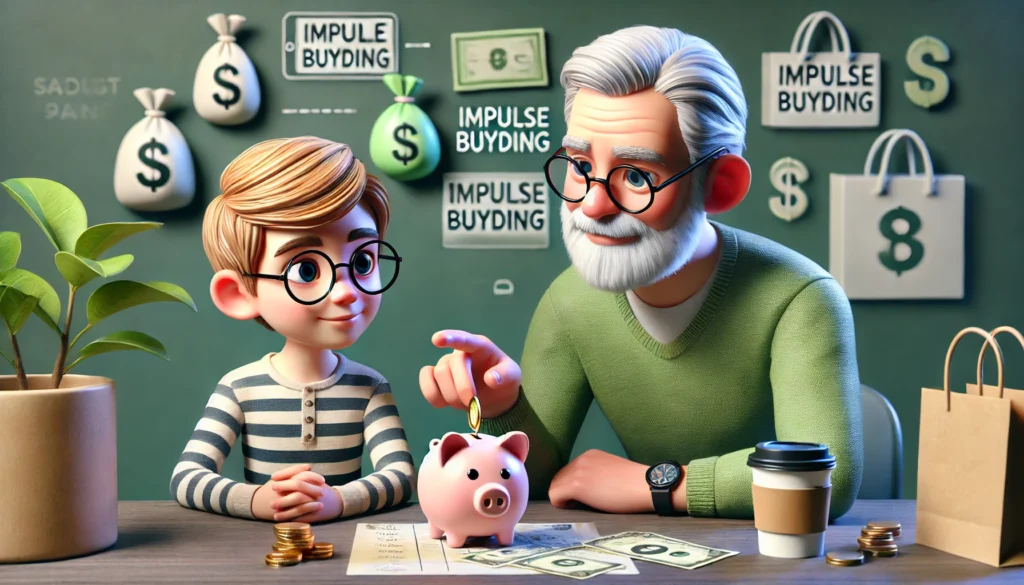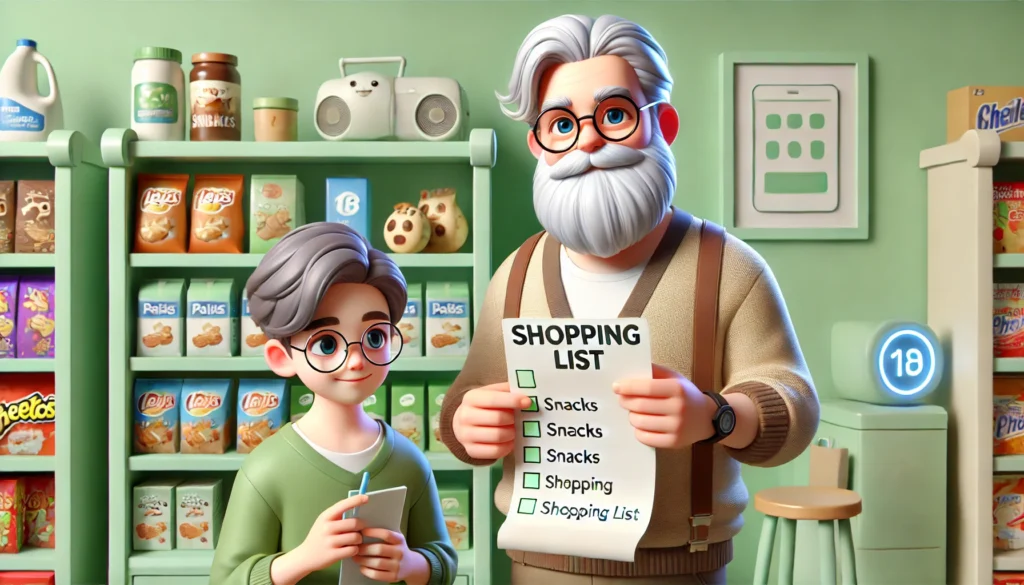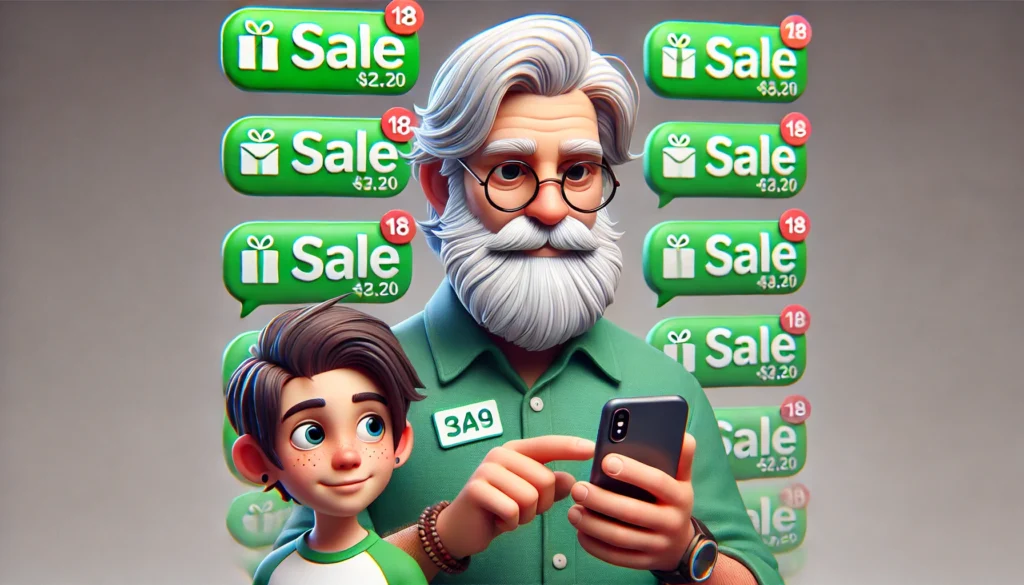Let me be honest here, my toughest impulsive buying weakness was food. I loved eating and indulging in tasty treats, not because I was hungry, but because the food just looked and smelled so good.
If I saw something delicious, I’d be ready to spend, whether it was a chocolate bar at the checkout line, a coffee from my favorite café, or the latest dessert craze in town.
My enemy was tasty food, and it was burning a hole in my wallet.
Hi buddy, if you’re like me, you probably know what I mean. It wasn’t about filling up my stomach; it was about craving that taste, that moment of pure satisfaction.
But soon, I realized these food cravings were eating up my savings, one snack at a time. I knew I needed to change. The question raised is how to stop impulse buying.
Table of Contents
What is Impulse Buying?
Impulse buying is that sudden, irresistible urge to make an unplanned purchase, often driven by emotions rather than actual need.
It’s the moment when you see a shiny new gadget or a tempting sale and decide to buy it without considering your long-term financial goals.
This behavior is fueled by the desire for instant gratification—getting that immediate thrill or satisfaction from acquiring something new.
Whether it’s grabbing a candy bar at the checkout line or splurging on a last-minute vacation, impulse buying can quickly derail your budget and savings plans.
How I Finally Controlled My Cravings

I learned that the trick wasn’t to cut out treats entirely that felt impossible. Instead, I started setting limits. I allowed myself one “fun food” purchase per week.
If I was really craving something, I’d make it my treat for the weekend. This approach gave me a sense of control. I could still enjoy good food, but without overspending.
Over time, my cravings reduced, and I could finally focus on reaching my financial goals instead of spending on quick, tasty fixes.
This approach helped me manage my impulsive spending habits effectively.
If Food Isn’t Your Thing—Other Impulse Buys You Might Face
While food was my biggest struggle, I know people who have impulsive spending habits with clothes, shoes, watches, games, or even gadgets.
We all have that one thing we can’t resist, that item that just calls our name. And the truth is, the underlying cause of all these impulses is the same: instant gratification and emotional fulfillment.
So, if clothes or gadgets are your weakness, don’t worry—you’re not alone. The base of impulse buying is the same, no matter what the item is. And because of that, the tips for overcoming these habits are universal.
Quick Guide to Controlling Impulse Buying
| Topic | Key Points | Quick Tips |
| Impulse Buying | Unplanned purchases driven by emotions | Recognize triggers: stress, boredom, social media ads |
| My Weakness: Food | Craving treats, not out of hunger | Limit to one “fun food” purchase per week |
| Common Triggers | Emotional state, discounts, convenience of online shopping | Be mindful of triggers that prompt impulse buys |
| Hack #1: Shopping List | Focused list reduces impulse purchases | Create “needs vs. wants” list, especially for online buys |
| Hack #2: Waiting Period | Waiting 24–48 hours reduces impulsive spending | Use a 24-hour rule before impulse purchases |
| Hack #3: Financial Goals | Goals help reduce impulse buying and build savings | Set clear goals like building a savings account |
| Hack #4: Reduce Triggers | Limit exposure to social media ads and brand emails | Unsubscribe from emails, unfollow brands |
| Hack #5: Use Cash | Cash reinforces mindful spending | Pay with cash for in-store purchases |
| Mindful Spending | Intentional spending aligns with financial goals | Reflect on needs vs. emotional spending |
| Emotional Spending | “Retail therapy” often leads to guilt | Find alternatives like exercise or connecting with friends |
| External Influences | Ads and cultural norms heighten impulse spending habits | Recognize external influences to spend mindfully |
| Hack #6: Track Spending | Tracking reveals impulse buying patterns | Use an app or notebook to log expenses |
| Hack #7: Set “Fun Money” | Monthly budget for guilt-free treats | Set aside fixed “fun money” each month |
| Hack #8: Budget Review | Monthly check-ins reveal savings progress | Review and adjust budget monthly |
| No-Spend Challenge | Breaks impulse spending cycle | Try a no-spend week or month to save |
| Cost of Impulse Buying | Average impulse buy: $81; adds up quickly | Know the impact on long-term financial goals |
Understanding Impulse Buying: Why Do We Buy Without Thinking?

Impulse buying refers to those unplanned purchases made without much thought, often driven by the promise of a good deal or an emotional need.
Many of us fall for the appeal of an impulse purchase when we’re after instant gratification, often spending money as a way to cope with emotions.
Recognizing our impulse buying habits is the first step toward managing them and breaking free from the urge to buy things we don’t truly need.
Common Triggers for Impulse Buys
- Emotional state: Impulse shopping is often triggered by boredom, stress, or just having a rough day.
- Sales and discounts: Limited-time offers and sales that seem like a “good deal” can lead to impulse purchases.
- Social media: Ads, promotions, and influencers make it seem like we “need” more than we actually do.
- Convenience of online shopping: The ease of online shopping is great but can encourage impulse spending without us realizing it.
HACK #1: Make a Shopping List—and Don’t Stray from It

I used to ignore advice about shopping lists, but once I started writing down exactly what I needed, I noticed I was much more focused.
Going into a store or browsing online with a clear shopping list kept me from getting distracted and reduced impulsive spending.
Now, my shopping lists keep me focused on planned purchases, helping me avoid impulse buys in the checkout line or while shopping online.
Bonus Tip:
When shopping online, keep a “needs vs. wants” list on your phone. If you’re tempted to add something, check if it’s really a “need” or just a “want.” This habit alone saved me from so many unnecessary impulse purchases.
HACK #2: Give Yourself a Waiting Period
The “waiting period” strategy transformed my impulsive spending. Anytime I felt the urge for an unplanned purchase, I’d wait 24 hours before buying.
This time period gave me a chance to evaluate whether it was an essential purchase or just emotional spending.
Often, the desire to buy faded away after some reflection, especially for impulse purchases triggered by social media ads.
Try a 24-48 Hour Rule:
This helps you resist impulse buys by waiting to see if you still feel the same way about the item after a day or two.
HACK #3: Set Clear Financial Goals You Can Get Excited About

Impulse buying used to keep me from saving money until I started setting specific financial goals. Knowing what I was working toward gave me a reason to say “no” to unnecessary purchases.
If you’re serious about building wealth, consider using one of the best investment apps to start growing your savings while resisting impulsive spending.
Whether it’s building a savings account, paying off credit card debt, or planning for a vacation, setting clear goals adds purpose to your spending habits and reduces the impulse to buy things you don’t need.
Setting clear financial goals helped me manage my impulsive spending habits.
Using a tool like our SIP Lumpsum Calculator can help you see your potential savings growth, making it easier to resist unnecessary expenses.
Did You Know?
Studies show that people who set clear savings goals are more likely to stick to their plans and resist impulse spending. Set an exciting goal for yourself, and you’ll feel more motivated to save.
HACK #4: Reduce Exposure to “Buying Triggers”

Social media and favorite stores were my biggest triggers. Limiting my exposure to them made a huge difference in managing my impulsive spending.
Unsubscribing from marketing emails, unfollowing brands on Instagram, and even deleting shopping apps from my phone helped me avoid impulse buys.
When you’re not constantly reminded to spend, it’s much easier to control your spending habits.
Example:
Every time I’d get a “50% off, today only!” email, I’d end up making an impulse buy. Now, unsubscribing from those emails helps me skip the temptation and focus on my financial goals.
HACK #5: Use Cash Instead of Cards for In-Store Shopping
Using cash instead of credit cards can be a game-changer for avoiding impulse spending. Physically handing over cash makes you feel the cost of each purchase more than swiping a card.
I found that cash made it easier to stick to a budget and avoid adding to my credit card debt.
Goodbye, impulse purchases and credit card debt!
Practice Mindful Spending

Practicing mindful spending is a powerful way to overcome impulse buying habits. It involves being fully present and aware of your thoughts, feelings, and actions when making purchasing decisions.
Instead of rushing into a purchase, take a moment to reflect on whether you truly need the item and how it aligns with your long-term financial goals.
This practice helps you slow down, consider the consequences of your spending, and make more intentional choices.
By adopting mindful spending habits, you can develop greater self-awareness, reduce impulsive purchases, and ultimately save money.
Emotional Triggers: Why We Buy More When We’re Stressed
Some of my worst impulsive spending happened on days when I was stressed, upset, or even just bored.
Often called “retail therapy,” this type of spending leads to temporary satisfaction but can result in buyer’s remorse.
Recognizing emotional triggers helped me find other ways to manage my mood without turning to impulse shopping.
Tips for Avoiding Emotional Spending
- Ask yourself: “Am I buying this because I’m stressed or because I truly need it?”
- Find alternatives to retail therapy: Exercise, call a friend, or read a book instead of shopping.
- Set limits: Decide in advance that you won’t spend money on bad days.

External Influences: Recognizing Outside Factors
External influences play a significant role in shaping our impulse buying habits.
Advertisements, social media, and cultural norms all contribute to the temptation to make impulsive purchases.
Retailers are masters at using tactics like eye-catching product placements, limited-time discounts, and enticing promotions to encourage us to buy on a whim.
Social media platforms amplify this by bombarding us with targeted ads and influencer endorsements, making it seem like we need the latest products to keep up.
By recognizing these external influences, we can become more aware of our impulse buying habits and make more informed financial decisions.
For more strategies to take control of your finances, explore StockDaddy’s homepage, where you’ll find insights on budgeting, smart investments, and practical tools to stay financially focused.
HACK #6: Track Your Spending Patterns
I was shocked when I first started tracking my spending habits.
Tracking helped me see where I was wasting money and how much I was spending on impulse buys.
Tools like these top expense tracker apps can simplify budgeting, giving you a clear view of where your money goes and revealing opportunities to save.
Whether you use an app or a simple notebook, jotting down every expense and reviewing it each month can reveal problem areas and help you adjust your budget.
Tracking helped me identify my impulsive spending habits and adjust my budget accordingly.
HACK #7: Set Aside “Fun Money” Each Month

Setting a fun money budget helped me enjoy life without feeling guilty about impulsive spending.
Now, I give myself a set amount each month to spend however I want—on clothes, eating out, or something special.
With fun money, you can enjoy a little spending freedom without hurting your savings plan or financial goals.
HACK #8: Regularly Check in on Your Budget and Goals
Reviewing my budget every month was one of the best habits I developed. It helped me stay on track and see how much I saved by avoiding impulse purchases.
It’s also a great time to reset spending limits or adjust for unexpected expenses.
Reviewing my budget helped me stay on track and manage my impulsive spending habits.
Try a No-Spend Challenge

A no-spend challenge is an excellent strategy to break the cycle of impulse buying and develop healthier spending habits.
The idea is simple: set a specific period, such as a week or a month, where you only spend money on essential expenses like rent, utilities, and groceries.
During this time, you avoid making non-essential purchases and focus on saving money and reducing debt.
This challenge can help you develop greater self-control, prioritize your financial goals, and make significant progress toward financial stability.
Plus, it can be a fun and rewarding way to see just how much you can save by cutting out unnecessary spending.
For even more practical tips, explore our guide on clever ways to save money and see how small changes can add up to significant savings.
Facts: The True Cost of Impulse Buying
Impulse buys can add up to thousands of dollars each year, affecting your savings and financial stability.
Here are some real numbers that motivated me to change my impulse buying habits:
- The average impulse buy costs around $81 per transaction.
- Impulse buys account for nearly 40% of consumer spending in the U.S.
- Most people don’t realize how much unplanned purchases affect their budget.
Key Takeaways: Hacks to Help You Control Impulse Spending
- Use a shopping list to stay focused on planned purchases and avoid impulsive spending.
- Implement a waiting period to reduce the urge to make impulsive purchases.
- Set clear financial goals to give your spending habits a sense of purpose.
- Limit exposure to social media ads and store promotions to avoid buying triggers.
- Use cash instead of cards to make spending more intentional.
Conclusion
Impulsive spending can feel like an unstoppable habit, but it’s possible to control.
I went from spending recklessly to saving intentionally by adopting these simple, practical changes.
Start by setting financial goals, tracking spending habits, and being mindful of emotional spending.
With a little patience and practice, you can stop impulse buying, avoid credit card debt, and reach your financial goals.
FAQs
Q1: How can I stop impulse buying while shopping online?
Avoid shopping on your phone, use a shopping list, and unsubscribe from marketing emails. Add items to a wish list and wait before purchasing to see if they’re really worth it.
Q2: Is it normal to feel guilty after an impulse buy?
Yes, guilt often follows impulsive spending because they’re unplanned. To avoid this, use the 24-hour waiting period, and remember your financial goals.
Q3: Can I still enjoy small treats without breaking my budget?
Absolutely! Setting aside fun money each month allows you to enjoy occasional treats without affecting your overall savings plan or budget.
Q4: How does impulse buying impact long-term savings goals?
Frequent impulse buys make it harder to reach long-term goals like building a savings account or planning a vacation. Curbing this habit frees up money for more meaningful uses

